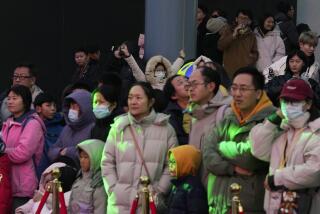China blames pollution for surge in birth defects
- Share via
BEIJING — Chinese officials told the state media that birth defects are increasing at an alarming rate and that a major reason was degradation of the environment.
“The number of newborns with birth defects is constantly increasing in both urban and rural areas,” Jiang Fan, vice minister of the National Population and Family Planning Commission, was quoted by the China Daily’s weekend edition as saying in a recent conference.
Environmentalists say that the leading culprit is China’s dependence on coal and that birth defects are highest in coal-producing regions such as Shanxi and Inner Mongolia.
Although Jiang did not give out new figures at last month’s conference, a study by the commission released in 2007 found that birth defects had increased nearly 40% from 2001 to 2006, coinciding with the country’s explosive economic growth.
The government’s acknowledgment was a victory for environmentalists, some of whom have faced arrest and harassment for trying to publicize the relationship between pollution and disease.
“So many people are wondering why, when our lives are supposed to be getting better, there are more and more babies born with birth defects and couples who are infertile,” said Huo Daishan, an environmental activist from Henan province who has been fighting against printing, paper manufacturing and chemical dye factories whose pollution he believes has caused disease clusters along the Huai River.
Greenpeace China has been campaigning against pollution from coal.
“The statement from the National Population and Family Planning Commission once again proved that coal burning is not only a climate killer, but one of the major health hazards in China,” Greenpeace China said in a statement Sunday.
Experts say it is extremely difficult to quantify the relationship between pollution and birth defects, particularly in China, where the government has until recently tried to downplay the environmental costs of economic growth.
Columbia University’s Center for Children’s Environmental Health in October released the results of a six-year study in the central Chinese city of Chongqing showing that pollution from a coal-fired power plant affected the birth weight, height and motor development skills of babies born nearby.
“It was clear that the pollutants caused damage to the DNA,” said Tang Deliang, a coauthor of the study. Tang applauded the government’s efforts to pay more attention to the problem. “This was something that people were strictly forbidden to talk about in the past.”
According to the government, the most common birth defects are cleft palate, neural tube defects, extra fingers or toes, and congenital heart disease. Researchers have said the sharp increase in birth defects is partially due to better reporting because more babies are born in hospitals nowadays rather than at home.
The World Health Organization puts the worldwide average rate of birth defects at 3% to 5%. But it is difficult to compare between countries because some measures include only physical defects detected at birth, and others include developmental delays that emerge later. As part of its population control measures, Chinese officials are more insistent on abortions if birth defects are suspected.
At the conference last month, family planning minister Li Bin was quoted as saying that a baby with birth defects is born in China every 30 seconds.
--
Eliot Gao of The Times’ Beijing Bureau contributed to this report.
More to Read
Sign up for Essential California
The most important California stories and recommendations in your inbox every morning.
You may occasionally receive promotional content from the Los Angeles Times.










